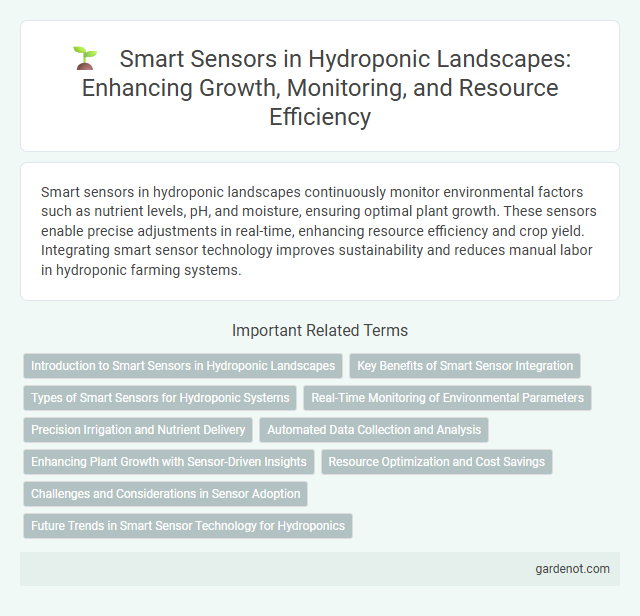Smart sensors in hydroponic landscapes continuously monitor environmental factors such as nutrient levels, pH, and moisture, ensuring optimal plant growth. These sensors enable precise adjustments in real-time, enhancing resource efficiency and crop yield. Integrating smart sensor technology improves sustainability and reduces manual labor in hydroponic farming systems.
Introduction to Smart Sensors in Hydroponic Landscapes
Smart sensors in hydroponic landscapes monitor critical parameters such as nutrient levels, pH, temperature, and humidity to optimize plant growth conditions. These sensors enable real-time data collection and automated adjustments, enhancing resource efficiency and crop yield. Integration of IoT technology allows for remote monitoring and precise control, reducing manual labor and minimizing risks of plant stress or disease.
Key Benefits of Smart Sensor Integration
Smart sensor integration in hydroponic landscapes optimizes plant health by continuously monitoring environmental factors such as moisture levels, pH, and nutrient concentration. This data-driven approach enhances resource efficiency, reducing water and fertilizer waste while promoting faster growth and higher yields. Real-time alerts and automated adjustments ensure consistent conditions, minimizing crop stress and maximizing productivity.
Types of Smart Sensors for Hydroponic Systems
Smart sensors in hydroponic systems include environmental sensors that monitor temperature, humidity, and light intensity to optimize plant growth conditions. Nutrient sensors measure pH and electrical conductivity (EC) levels to ensure precise nutrient delivery and prevent imbalances. Water quality sensors detect dissolved oxygen and moisture levels, enhancing root health and overall system efficiency.
Real-Time Monitoring of Environmental Parameters
Smart sensors in hydroponic landscapes enable real-time monitoring of critical environmental parameters such as pH, nutrient levels, humidity, and temperature, ensuring optimal plant growth conditions. These sensors provide continuous data streams that allow for immediate adjustments to maintain balanced nutrient delivery and prevent stress or disease. Integration of IoT technology enhances precision agriculture by automating climate control and resource management, maximizing yield and sustainability.
Precision Irrigation and Nutrient Delivery
Smart sensors in hydroponic landscapes enable precision irrigation and nutrient delivery by continuously monitoring soil moisture, pH levels, and nutrient concentrations. These advanced sensors optimize water usage and nutrient application, promoting healthier plant growth and reducing waste. Real-time data from smart sensors allows automated adjustments that enhance crop yield and resource efficiency.
Automated Data Collection and Analysis
Smart sensors in hydroponic landscapes enable automated data collection and analysis by continuously monitoring parameters such as pH, nutrient levels, temperature, and humidity. These sensors transmit real-time data to cloud-based platforms, facilitating precise adjustments to optimize plant growth and resource efficiency. Integration of AI-driven analytics enhances predictive maintenance and environmental control, maximizing yield and reducing operational costs.
Enhancing Plant Growth with Sensor-Driven Insights
Smart sensors in hydroponic landscapes monitor key environmental factors like nutrient levels, pH balance, and humidity with high precision, enabling real-time adjustments to optimize plant growth. These sensor-driven insights reduce resource waste and increase crop yield by providing data that supports tailored nutrient delivery and climate control. Integrating IoT-enabled sensors improves overall system efficiency, ensuring healthier plants and faster growth cycles.
Resource Optimization and Cost Savings
Smart sensors in hydroponic landscapes enable precise monitoring of nutrient levels, pH, and moisture, enhancing resource optimization by reducing water and fertilizer waste. These sensors provide real-time data that help automate irrigation and nutrient delivery, significantly lowering operational costs. Implementing smart sensor technology can result in up to 30% savings in resource use and a marked decrease in maintenance expenses.
Challenges and Considerations in Sensor Adoption
Smart sensor adoption in hydroponic landscapes faces challenges such as sensor calibration accuracy, environmental interference, and data integration complexity. Ensuring reliable real-time monitoring requires addressing sensor placement and maintenance to prevent biofouling or damage from nutrient solutions. Cost considerations and compatibility with existing control systems also play critical roles in effective sensor implementation.
Future Trends in Smart Sensor Technology for Hydroponics
Advancements in smart sensor technology for hydroponics are enabling precise monitoring of nutrient levels, pH balance, and environmental conditions to optimize plant growth. Future trends emphasize integration with AI-driven analytics and IoT frameworks, allowing real-time data collection and automated adjustments in hydroponic systems. Enhanced sensor accuracy and wireless connectivity are set to revolutionize resource efficiency and reduce operational costs in hydroponic landscaping.
Smart sensor Infographic

 gardenot.com
gardenot.com